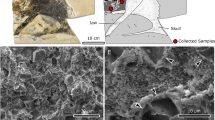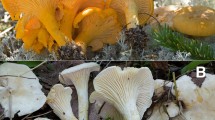Abstract
WHEN I first approached this subject now some eight years ago our knowledge of the lipoid constituents of the Algæ, especially the carotenoid pigments and sterols, was exceedingly meagre. A partial survey of the algal pigments had been made by Kylin1, but in the light of the precise knowledge of the lipochromes of the higher plants the pigments described by him required re-examination, the more so as his method of detection was purely qualitative and it is uncertain whether the carotenoids described represent distinct chemical individuals. As regards the occurrence of sterols among the Algæ no information whatsoever was available. In view of the recognized importance of these lipoids in relation to physiological factors, and bearing in mind the accepted botanical relationship between colour and classification, it seemed of importance to study both classes of compounds in detail.
This is a preview of subscription content, access via your institution
Access options
Subscribe to this journal
Receive 51 print issues and online access
$199.00 per year
only $3.90 per issue
Buy this article
- Purchase on Springer Link
- Instant access to full article PDF
Prices may be subject to local taxes which are calculated during checkout
Similar content being viewed by others
References
Kylin, Z. physiol. Chem., 166, 39 (1927).
Fritsch, "The Structure and Reproduction of the Algæ", Vol. 1. Camb. Univ. Press (1935).
Carter, Heilbron and Lythgoe, Proc. Roy. Soc., B, 128, 62 (1939).
Tischer, Z. physiol. Chem., 243, 103 (1936).
Willstätter and Page, Annalen, 404, 237 (1914).
Seybold and Egle, Jahrb. wiss. Bot., 86, 50 (1938).
Kuhn and Brockmann, Z. physiol. Chem., 213, 192 (1932).
Heilbron, Parry and Phipers, Biochem.J., 29, 1976 (1935).
Heilbron, Lythgoe and Phipers, NATURE, 136, 989 (1935).
Heilbron and Lythgoe, J. Chem. Soc., 1376 (1936).
Tischer, Z. physiol. Chem., 251, 109 (1938).
Tischer, Z. physiol. Chem., 239, 257 (1936).
Tischer, Z. physiol. Chem., 250, 147 (1937); 252, 225 (1938).
Kuhn, Stene and Sörensen, Ber., 72, 1688 (1939).
Moewus, Arch, für Protistenkunde, 20, 469 (1933).
Kuhn, Moewus and Jerchel, Ber., 71, 1541 (1938).
Kuhn, Moewus and Wendt, Ber., 72, 1702 (1939).
Kuhn, Angew. chem., 53, 1 (1940).
Carter, Cross, Heilbron and Jones, unpublished work.
Emerson and Fox, Proc. Roy. Soc., B, 128, 275 (1940).
Kuhn and Wallenfels, Ber., 72, 1407 (1939).
Author information
Authors and Affiliations
Rights and permissions
About this article
Cite this article
HEILBRON, I. SOME ASPECTS OF ALGAL CHEMISTRY*. Nature 149, 398–400 (1942). https://doi.org/10.1038/149398a0
Issue Date:
DOI: https://doi.org/10.1038/149398a0
This article is cited by
-
Using visible near-infrared reflectance spectroscopy (VNIRS) of lake sediments to estimate historical changes in cyanobacterial production: potential and challenges
Journal of Paleolimnology (2020)
-
The lipid-soluble pigments of the marine red algaLenormandia prolifera
Helgoländer Wissenschaftliche Meeresuntersuchungen (1968)
-
Pigmentation and Sexuality in Plants
Nature (1958)
Comments
By submitting a comment you agree to abide by our Terms and Community Guidelines. If you find something abusive or that does not comply with our terms or guidelines please flag it as inappropriate.



